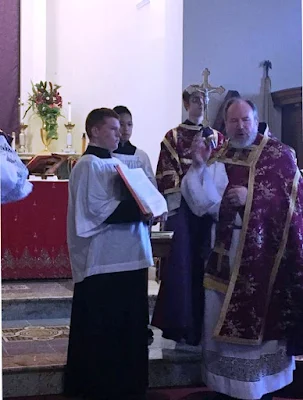Before we tackle the mountain of photopost submissions for the Triduum and Easter, we have one last Palm Sunday set to share with you. The church of the Holy Name in Providence, Rhode Island, traditionally celebrates Palm Sunday according to the Use of Braga. (There are a lot of Portuguese people in Rhode Island and some of the cities in Massachusetts like Fall River; the pastor of Holy Name, Fr Joseph Santos, is incardinated in Braga, whose clergy have an automatic indult to celebrate according to their native Use anywhere, like the Ambrosian clergy.) Shawn Tribe published an article about this in 2009, with pictures from Holy Name, and a description of the ceremony from Archdale King’s book The Liturgies of the Primatial Sees. However, the pictures from that article are now gone (I have no idea why), so I here reproduce it with photos from this year’s ceremony. Note the tunicles worn by the acolytes, a fairly common custom in the Middle Ages, and one which it would not be a bad to revive more broadly at some point.
...the high altar is vested in purple, with the statues uncovered until after the procession, when the altar and statues are covered again as before. A cope is worn by the celebrant, and dalmatics by the assistant ministers; while the two thurifers, crucifer and taperers have girdled albs and dalmatics. ...a table was set in the middle of the nave, with a white cloth and two candles.... the palms are sprinkled and censed...
Outside... is sung: Ave, Rex Noster, Fili David, Redemptor Mundi... The first words are repeated three times and three genuflections are made while the celebrant scatters leaves of blessed olive... The ceremony of Ave, Rex Noster was found in most churches which followed Franco-Roman customs, and it exists today in the Cistercian, Premonstratensian, Carmelite and Dominican rites. We find it at Cluny, from whence it may have come to Braga...
At the conclusion of the antiphon, Gloria, laus, et honor is sung... the celebrant strikes the doors with the end of the processional cross, as he says, Attolite portas, principes vestras: et elevamini portae aeternales, et introibit Rex gloriae. From within the church the choir respond: Quis est iste Rex gloriae? To which the celebrants answers, Dominus fortis et potens. This is repeated three times, but on the second occasion the celebrant says: Dominus potens in proelio, and on the third: Dominus virtutum ipse est Rex gloriae. The ceremony was common in France in the 11th century, and many examples of its use are given...
The procession enters the church singing the responsory Ingrediente, followed by the verse Cumque audissent: the organ peals out, and the Lenten veil is drawn back. The sacred ministers then go to the sacristy to vest for Mass: the deacon and subdeacon exchanging dalmatics for folded chasubles, with a second subdeacon similarly vested to carry the processional cross. The thurifer and taperers have girded albs, without dalmatics. Mass follows.
...the high altar is vested in purple, with the statues uncovered until after the procession, when the altar and statues are covered again as before. A cope is worn by the celebrant, and dalmatics by the assistant ministers; while the two thurifers, crucifer and taperers have girdled albs and dalmatics. ...a table was set in the middle of the nave, with a white cloth and two candles.... the palms are sprinkled and censed...
Outside... is sung: Ave, Rex Noster, Fili David, Redemptor Mundi... The first words are repeated three times and three genuflections are made while the celebrant scatters leaves of blessed olive... The ceremony of Ave, Rex Noster was found in most churches which followed Franco-Roman customs, and it exists today in the Cistercian, Premonstratensian, Carmelite and Dominican rites. We find it at Cluny, from whence it may have come to Braga...
At the conclusion of the antiphon, Gloria, laus, et honor is sung... the celebrant strikes the doors with the end of the processional cross, as he says, Attolite portas, principes vestras: et elevamini portae aeternales, et introibit Rex gloriae. From within the church the choir respond: Quis est iste Rex gloriae? To which the celebrants answers, Dominus fortis et potens. This is repeated three times, but on the second occasion the celebrant says: Dominus potens in proelio, and on the third: Dominus virtutum ipse est Rex gloriae. The ceremony was common in France in the 11th century, and many examples of its use are given...
The procession enters the church singing the responsory Ingrediente, followed by the verse Cumque audissent: the organ peals out, and the Lenten veil is drawn back. The sacred ministers then go to the sacristy to vest for Mass: the deacon and subdeacon exchanging dalmatics for folded chasubles, with a second subdeacon similarly vested to carry the processional cross. The thurifer and taperers have girded albs, without dalmatics. Mass follows.











